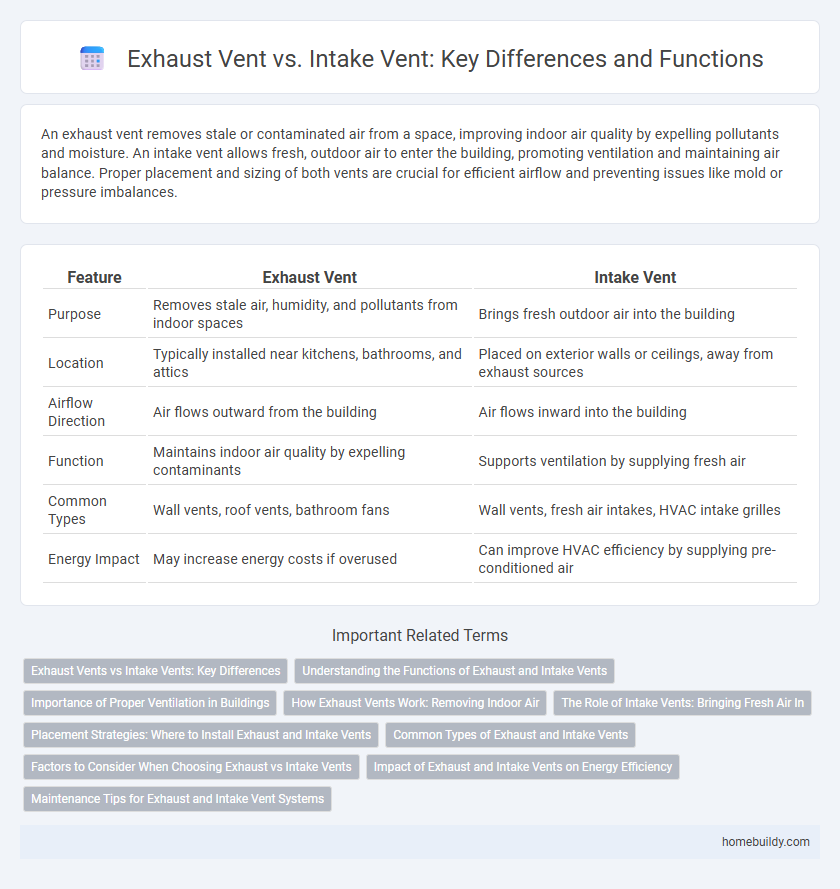An exhaust vent removes stale or contaminated air from a space, improving indoor air quality by expelling pollutants and moisture. An intake vent allows fresh, outdoor air to enter the building, promoting ventilation and maintaining air balance. Proper placement and sizing of both vents are crucial for efficient airflow and preventing issues like mold or pressure imbalances.
Table of Comparison
| Feature | Exhaust Vent | Intake Vent |
|---|---|---|
| Purpose | Removes stale air, humidity, and pollutants from indoor spaces | Brings fresh outdoor air into the building |
| Location | Typically installed near kitchens, bathrooms, and attics | Placed on exterior walls or ceilings, away from exhaust sources |
| Airflow Direction | Air flows outward from the building | Air flows inward into the building |
| Function | Maintains indoor air quality by expelling contaminants | Supports ventilation by supplying fresh air |
| Common Types | Wall vents, roof vents, bathroom fans | Wall vents, fresh air intakes, HVAC intake grilles |
| Energy Impact | May increase energy costs if overused | Can improve HVAC efficiency by supplying pre-conditioned air |
Exhaust Vents vs Intake Vents: Key Differences
Exhaust vents remove stale air, moisture, and pollutants from indoor spaces to maintain air quality and prevent mold growth, while intake vents supply fresh outdoor air to ensure proper ventilation and balance air pressure. Exhaust vents are typically located near sources of heat, moisture, or contaminants, such as bathrooms or kitchens, whereas intake vents are positioned to draw in clean air from outside, often facing away from pollution sources. Understanding these differences helps optimize HVAC system efficiency and enhances indoor comfort and health.
Understanding the Functions of Exhaust and Intake Vents
Exhaust vents remove stale, humid, or contaminated air from indoor spaces to improve air quality and prevent moisture buildup. Intake vents bring fresh outdoor air inside, promoting proper airflow and maintaining balanced pressure within the ventilation system. Effective ventilation relies on the coordinated function of both exhaust and intake vents to ensure optimal indoor air circulation and comfort.
Importance of Proper Ventilation in Buildings
Proper ventilation in buildings relies on a balanced system of exhaust vents and intake vents to maintain indoor air quality and prevent moisture buildup. Exhaust vents remove stale air and contaminants while intake vents supply fresh air, ensuring effective air circulation and reducing the risk of mold growth and respiratory issues. Maintaining this equilibrium is essential for energy efficiency, structural integrity, and occupant health in residential and commercial buildings.
How Exhaust Vents Work: Removing Indoor Air
Exhaust vents function by drawing stale or humid indoor air out of living spaces, preventing the buildup of pollutants and moisture that can compromise air quality. These vents rely on natural airflow or mechanical fans to expel air through duct systems to the outside environment, maintaining proper ventilation and reducing indoor allergens. By continuously removing contaminated air, exhaust vents help regulate indoor humidity and support overall HVAC system efficiency.
The Role of Intake Vents: Bringing Fresh Air In
Intake vents play a crucial role in maintaining indoor air quality by allowing fresh air to enter a building, promoting ventilation and preventing stagnation. These vents are designed to regulate airflow, ensuring that pollutants and excess moisture are efficiently diluted and expelled through exhaust vents. Properly positioned intake vents optimize energy efficiency by balancing pressure and facilitating natural air circulation.
Placement Strategies: Where to Install Exhaust and Intake Vents
Proper placement of exhaust and intake vents is essential for optimal air circulation and ventilation efficiency. Intake vents should be installed near ground level or in cooler areas to draw fresh air into the system, while exhaust vents are best positioned at higher points or near ceilings to expel warm, stale air effectively. Strategic placement ensures continuous airflow, reduces indoor pollutants, and maintains balanced pressure within the space.
Common Types of Exhaust and Intake Vents
Common types of exhaust vents include roof vents, ridge vents, and gable vents, which effectively expel hot air and moisture from attics or enclosed spaces. Intake vents, such as soffit vents, foundation vents, and wall vents, facilitate the inflow of fresh air to maintain proper ventilation and prevent condensation buildup. Properly balancing exhaust and intake vents is crucial for optimal airflow and energy efficiency in residential and commercial buildings.
Factors to Consider When Choosing Exhaust vs Intake Vents
When choosing between exhaust vents and intake vents, consider airflow direction, ventilation goals, and room size to ensure optimal air exchange. Exhaust vents remove stale or contaminated air, while intake vents supply fresh air, balancing indoor air quality and pressure. Material durability, noise levels, and energy efficiency also play critical roles in selecting the appropriate vent type for HVAC systems.
Impact of Exhaust and Intake Vents on Energy Efficiency
Exhaust vents remove stale air and reduce indoor humidity, preventing moisture buildup that can cause energy loss through damaged insulation. Intake vents supply fresh air, improving indoor air quality and supporting balanced airflow, which enhances HVAC system efficiency by reducing the workload. Properly designed and positioned exhaust and intake vents minimize energy consumption by maintaining optimal ventilation and temperature regulation.
Maintenance Tips for Exhaust and Intake Vent Systems
Regularly inspect exhaust vents to remove debris and prevent blockages that reduce airflow efficiency, while intake vents should be cleaned to avoid dust buildup that can compromise indoor air quality. Schedule professional HVAC maintenance biannually to ensure both exhaust and intake vent systems operate at optimal performance and to detect potential issues early. Replace air filters monthly and verify that vent covers remain intact and unobstructed to maintain proper ventilation balance and system longevity.
exhaust vent vs intake vent Infographic

 homebuildy.com
homebuildy.com